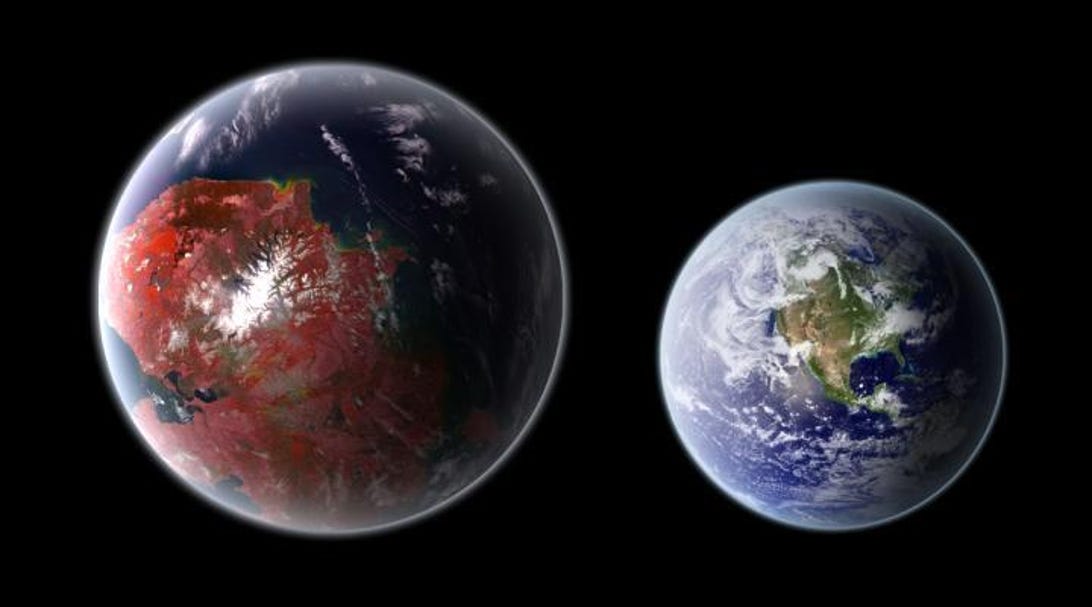
The potentially habitable exoplanet Kepler 422-b (left) compared with Earth (right)
Ph03nix1986/Wikimedia CommonsDiscovering exoplanets, those that lie outside of our solar system, has become fairly routine, thanks to some of the workhorse telescopes NASA and other space agencies have developed in the past two decades. Kepler has found thousands, including hellish lava planets, and TESS, launched in 2018, continues to tally up its own collection of strange worlds.
But for all the worlds we're finding, very few sit in the "Goldilocks zone" -- a region around a star where the conditions are just right for liquid water to be present on the surface. Get too close to a star and the stuff boils away, too far out and it freezes. That makes it pretty hard for life -- as we know it -- to get a start.
Only a few dozen exoplanets discovered lie within the Goldilocks zone around their host stars, limiting the list of potentially habitable worlds scientists can probe for signs of alien existence. Typically, we look for worlds similar to our own. After all, Earth hosts living, breathing creatures of unfathomable variety, so similar conditions elsewhere should facilitate the same thing.
But some bad news for alien astronomers: Planets capable of sustaining life like Earth does seem pretty rare.
In a new study, published in the journal Monthly Notices of the Royal Astronomical Society, researchers studied 10 Earth-like planets in the Goldilocks zone, with a particular focus on measuring their capacity for oxygen-based photosynthesis, which they call OP.
On Earth, OP is critical. This is the same type of photosynthesis that powers plants. Light is absorbed and eventually converted to chemical energy. Complex life practically depends on the process on Earth, and very few organisms generate energy in other ways. The researchers suggest this process should be quite common in the cosmos because all planets receive light from their host stars.
Determining how much OP might be occurring on an exoplanet is possible by examining how much light is likely to reach the planet -- based on the distance to its host star and how hot and bright that star is. This measure helped the team calculate the "photosynthetically active radiation," or PAR, that a planet might receive.
Looking at 10 Earth analogues, the team found none come close to the amount of PAR Earth receives and thus couldn't sustain a biosphere like our own.
Red dwarf stars like Trappist-1 and Proxima Centauri don't shine as brightly or generate the same amount of heat as our sun does. That reduces the amount of PAR reaching exoplanets in their orbit. Because red dwarfs are the most common star in the Milky Way, the finding signals, perhaps, a second Earth might not be as common as astronomers had hoped.
"This study puts strong constraints on the parameter space for complex life, so unfortunately it appears that the 'sweet spot' for hosting a rich Earth-like biosphere is not so wide," said Giovanni Covone, an astrophysicist at the University of Naples and lead author of the study. Essentially, the Goldilocks zone may not be quite as broad as we thought.
However, the team did identify a slightly more promising target: Kepler-442b, which lies over 1,200 light-years from Earth. Kepler-442b is a little larger than Earth and twice as massive and has previously been earmarked as a potentially habitable exoplanet. It receives the largest amount of PAR in the studied planets and theoretically might be able to sustain the same amount of life as Earth does.
The researchers caution their method does have limitations. They only focused on how much light is reaching these Earth-like planets, but the OP process is much more complex. They also neglected some of the scenarios that reduce the efficiency of the light reaching a particular planet -- for instance, the fact some planetary atmospheres may absorb the light or cloud cover might prevent it from reaching the surface.
Article From & Read More ( Earth-like worlds in the Milky Way may be a lot less common than we thought - CNET )https://ift.tt/3qs03X9
Science
No comments:
Post a Comment